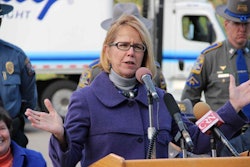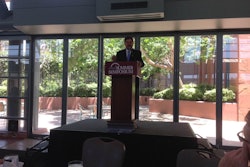 Outgoing FMCSA Administrator Anne Ferro defended her agency’s 2013 hours-of-service rule, saying it reduces driver fatigue and prevents crashes. She also talked up CSA and the agency’s other regulatory initiatives. Trucking groups like ATA and OOIDA, however, took the agency to task, saying it should refocus some of its rulemakings to actions known to cause crashes.
Outgoing FMCSA Administrator Anne Ferro defended her agency’s 2013 hours-of-service rule, saying it reduces driver fatigue and prevents crashes. She also talked up CSA and the agency’s other regulatory initiatives. Trucking groups like ATA and OOIDA, however, took the agency to task, saying it should refocus some of its rulemakings to actions known to cause crashes.At a Senate hearing on truck safety Tuesday, regulators and trucking trade groups offered testimony to lawmakers in the Senate’s commerce committee about what could be done to improve truck safety in the U.S.
Here’s a roundup of some of the statements made by participating parties:
Federal Motor Carrier Safety Administration
In what was likely her last appearance before Congress before leaving her post as head of FMCSA, Administrator Anne Ferro spoke on a bevy of topics, including the 2013 hours-of-service rule (which she stood behind), the agency’s Compliance, Safety, Accountability program, electronic logging devices, sleep apnea, driver training requirements and more.
Hours-of-service items, however, took up the bulk of her testimony. She defended the agency’s 2013-implemented hours-of-service regulations, again reiterating that it was the result of “extensive research and data.”
She also reiterated this oft-cited point: The agency, per its analysis, only sees the 2013’s 34-hour restart provisions affecting 15 percent of drivers who must keep records of duty status.
“Whatever the limits on driving and work hours may be, if the motor carrier and driver plan their schedule so tightly that the driver can barely complete the run legally, then problems with completing runs inevitably will occur,” Ferro said. “That fact cannot support any rollback of the current rule.”
She also touted the benefits of nighttime sleep vs. daytime sleep, saying the rule’s requirement that a weekly restart include two 1 a.m. to 5 a.m. periods pushes drivers to nighttime rest.
Likewise, the agency’s CSA program and its Safety Measurement System carrier ranking system improves carrier and driver safety, Ferro said.
The agency’s use of the SMS as an intervention prioritization tool “will lead to improved safety and fewer crashes,” Ferro said.
In her testimony, Ferro also pointed to other agency rulemakings — like the National Registry of Certified Medical Examiners, the ELD mandate, the drug and alcohol clearinghouse, anti-coercion rule and preliminary work on entry-level driver training — as work it has done to promote safety.
American Trucking Associations
ATA Executive VP Dave Osiecki, speaking on what the industry does for safety, says trucking invests $7.5 billion each year into crash-prevention, including investments in safety training, safety-related bonsus, incentives for drivers and into safety technology like collision mitigation, active braking, video monitoring and ELDs.
“Over the past decade the number of large trucks involved in fatal crashes has dropped 17% – even with the industry operating an additional 2.7 million trucks and driving an additional 54 billion miles,” Osiecki said. “More trucks, billions more miles, fewer crashes.”
Osiecki said priorities for trucking regulators should include rules that reduce truck speed, encourage stability control systems and require electronic logs. He also said aggresive on-road enforcement of driver behavior — passenger cars included — would help reduce crashes.
“Driver error causes most crashes,” he said. “More specifically, driver mistakes and driver misbehaviors — by both professional drivers and passenger vehicle drivers. In fact, car drivers contribute significantly to truck crash numbers.”
The “regulatory, enforcement and safety program lens” should be focused on “the most common mistakes and misbehaviors,” Osiecki said.
Owner-Operator Independent Drivers Association
OOIDA’s Todd Spencer told lawmakers that FMCSA’s priorities have been misaligned relative to highway safety measures. FMCSA’s “focus should instead be on causes of crashes rather than micromanaging policies that have a negative impact on safety,” he said.
Spencer, executive VP for OOIDA, said the agency should make driver training a priority, and he pointed lawmakers and FMCSA to OOIDA’s recently unveiled TruckersforSafety.com site, which lobbies for the next highway bill to tackle a driver training rule, along with changing the way FMCSA operates and produces rules.
Per OOIDA, “the campaign looks at ways to improve highway safety without imposing burdensome regulations in a variety of areas.
To read more on OOIDA’s proposed safety initiatives, see CCJ sister site Overdrive’s coverage from April.











